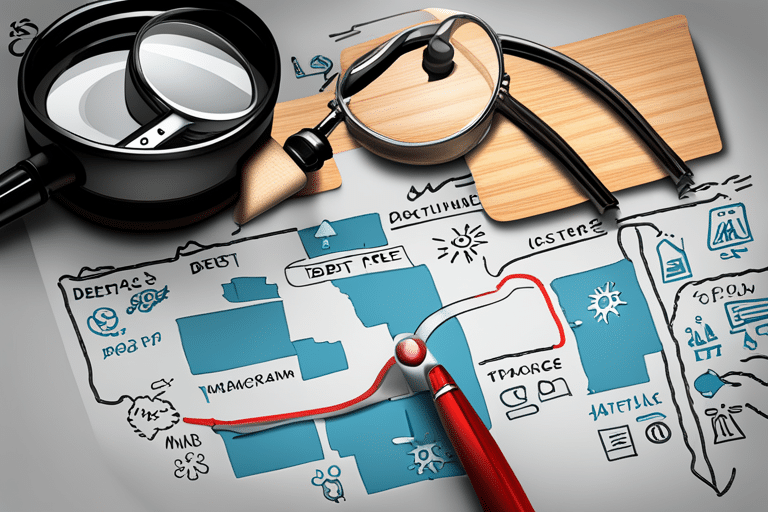Are you tired of feeling overwhelmed by debt? Ready to take control of your financial future?
Setting realistic goals is the key to guiding your debt-free journey. By assessing your current situation, creating a budget, and prioritizing repayment strategies, you can make tangible progress towards financial freedom.
And don’t worry, tracking your progress and adjusting goals along the way will ensure you stay on track.
It’s time to master your finances and pave the way for a brighter future!
Key Takeaways
- Prioritize setting achievable financial goals to stay on track towards becoming debt-free.
- Breaking down larger goals into smaller milestones makes the journey less daunting.
- Celebrating each milestone along the way keeps you motivated and reminds you of your progress.
- Assess your current financial situation to evaluate expenses, income sources, and potential savings.
The Importance of Setting Achievable Financial Goals

You should prioritize setting achievable financial goals if you want to stay on track towards becoming debt-free. Think of it as embarking on a thrilling adventure, where each milestone reached brings you closer to your ultimate goal. Picture yourself standing at the summit, celebrating your triumph over debt with a big smile on your face. But to get there, you need motivation and a clear roadmap.
Setting realistic financial goals is like having a compass that guides you through the twists and turns of your debt-free journey. It keeps you focused and motivated when things get tough. Whether it’s paying off a credit card or saving for an emergency fund, breaking down your larger goal into smaller milestones will make the journey seem less daunting.
Imagine how rewarding it would feel to celebrate each milestone along the way. Treat yourself to something special—a small indulgence or an experience that brings joy—when you reach those mini-goals. These celebrations will not only keep you motivated but also remind you of how far you’ve come.
Now that you understand the importance of setting achievable financial goals and celebrating milestones, let’s move on to assessing your current financial situation…
Assessing Your Current Financial Situation

Take a moment to evaluate where you currently stand financially. It’s time to dive into the nitty-gritty of your expenses and income sources.
Assessing your expenses and identifying your income sources are crucial steps in determining your financial health. So, grab a cup of coffee, sit back, and let’s get started!
-
Expenses – Make a list of all your monthly expenses – from rent/mortgage payments to those sneaky little subscriptions that slowly drain your bank account.
-
Income Sources – Jot down all the ways money flows into your life. Whether it’s through a steady paycheck or side hustles, knowing where your money comes from is key.
Now that you have these lists in front of you, take a good look. Are there any unnecessary expenses that can be cut? Can you find additional income streams?
Remember, this assessment isn’t meant to make you feel overwhelmed. Instead, think of it as an adventure – an opportunity to uncover hidden treasures in the form of savings and increased earnings.
Creating a Realistic Budget to Pay off Debt

Creating a budget that reflects your income and expenses is essential for paying off debt. But who says budgeting has to be boring? Think of it as an adventure, a journey towards financial freedom! Picture yourself as the captain of your own ship, navigating through the treacherous waters of debt repayment.
First things first, gather all your financial information. Take a deep breath and dive into those bank statements, credit card bills, and loan documents. It might feel overwhelming at first, but remember, you’re in control now!
Next, start mapping out your budget. Imagine it as a treasure map leading you towards buried riches – in this case, being debt-free! Identify your income sources and write them down on one side of the map. Then chart out all your expenses on the other side. Be thorough! List everything from housing and utilities to groceries and entertainment.
Now comes the fun part: finding creative ways to cut back on expenses. Look for hidden treasures within your spending habits – maybe that daily cup of fancy coffee could become an occasional treat instead? Or how about swapping expensive gym memberships for free outdoor workouts?
Lastly, prioritize debt repayment strategies in your budget. Allocate extra funds towards paying off high-interest debts or consider consolidating them into one manageable payment.
Prioritizing Debt Repayment Strategies

Now comes the exciting part – charting out a plan to tackle your debts and prioritize repayment strategies. It’s time to put on your debt-slaying cape and unleash your financial superhero powers! But fear not, for I am here to guide you through this exhilarating journey.
Here are some creative ways to prioritize your debt repayment:
-
Debt Snowball: This strategy involves listing all your debts from smallest to largest balance, regardless of interest rates. Start by paying off the smallest debt first while making minimum payments on the rest. As you eliminate each debt, roll that payment into the next one. It’s like a snowball rolling down a hill, gaining momentum as it goes!
-
Debt Avalanche: In this approach, you focus on tackling high-interest debts first. List your debts in order of interest rates and start by paying off the one with the highest rate. Once that’s gone, move on to the next highest until you’ve conquered them all. Imagine yourself skiing down a mountain slope, gracefully overcoming each hurdle.
-
Seek Professional Advice: If you feel overwhelmed or unsure about which strategy suits you best, don’t hesitate to seek professional advice. Financial experts can provide tailored guidance based on your unique circumstances and help you make informed decisions.
Tracking Progress and Adjusting Goals Along the Way

As you continue on your path to becoming debt-free, it’s essential to track your progress and make adjustments to your goals along the way. Think of it as navigating through a maze – you start with a plan, but sometimes you need to take detours or find shortcuts to reach your destination faster.
Tracking your progress is like having a map that shows you which paths are working and which ones are leading you astray.
So, grab a pen and paper (or use an app if that’s more your style) and start jotting down the numbers. Keep track of how much debt you’ve paid off each month, how much money you’re saving, and any unexpected expenses that pop up along the way. This will give you a clear picture of where you stand financially.
But remember, tracking progress isn’t just about crunching numbers – it’s also about staying motivated. Celebrate each milestone along the way, whether it’s paying off a credit card or reaching a certain amount in savings. Treat yourself to something small as a reward for all your hard work.
Now let’s talk about goal adjustment. As you track your progress, don’t be afraid to adjust your goals if necessary. Life happens, and circumstances change. Maybe you got hit with an unexpected medical bill or lost some income due to unforeseen circumstances. It’s okay! Take a deep breath and reassess your situation.
Be flexible with yourself – if needed, extend the timeline for becoming debt-free or adjust the amount of money you allocate towards repayment each month. The key is finding balance between pushing yourself towards financial freedom while still being realistic about what is achievable in your current situation.
Frequently Asked Questions
What Are Some Common Mistakes People Make When Setting Financial Goals?
Common mistakes when setting financial goals include being too vague, not considering your current financial situation, and setting unrealistic expectations. To succeed, create specific goals, assess your finances realistically, and break down your objectives into manageable steps.
How Can I Stay Motivated While Working Towards My Financial Goals?
You can stay motivated and maintain discipline on your financial journey by visualizing your goals, celebrating small wins, and finding a support system. Remember, every step forward brings you closer to financial freedom!
Are There Any Tools or Resources Available to Help Me Set and Track My Financial Goals?
Looking to set and track your financial goals? There are awesome tools out there like financial goal setting apps and online trackers that can help you stay organized and motivated on your debt-free journey.
Is It Possible to Pay off Debt Faster Than Originally Planned, and if So, How?
You can definitely pay off debt faster than planned! Try these strategies: increase your income, cut expenses, and prioritize high-interest debt. With determination and discipline, you’ll maximize your debt payoff in no time!
How Can I Incorporate Unexpected Expenses Into My Financial Goals?
You’re on a debt-free journey, but unexpected expenses can throw you off track. Incorporate them into your financial goals by setting aside a percentage of your income each month for emergencies. Stay prepared and stay focused!
Conclusion
Congratulations! You’ve reached the end of your journey towards financial freedom.
Now, take a moment to reflect on how setting realistic goals has guided you along this debt-free path. It’s like navigating through a magical forest, where each step brings you closer to your dreams.
By assessing your current situation and creating a budget, you’ve unlocked the secret to paying off debt. Remember, progress may not always be smooth sailing, but with determination and the ability to adapt, you’ll conquer any obstacle that comes your way.
So go forth, embrace your newfound financial power, and live happily ever after!

